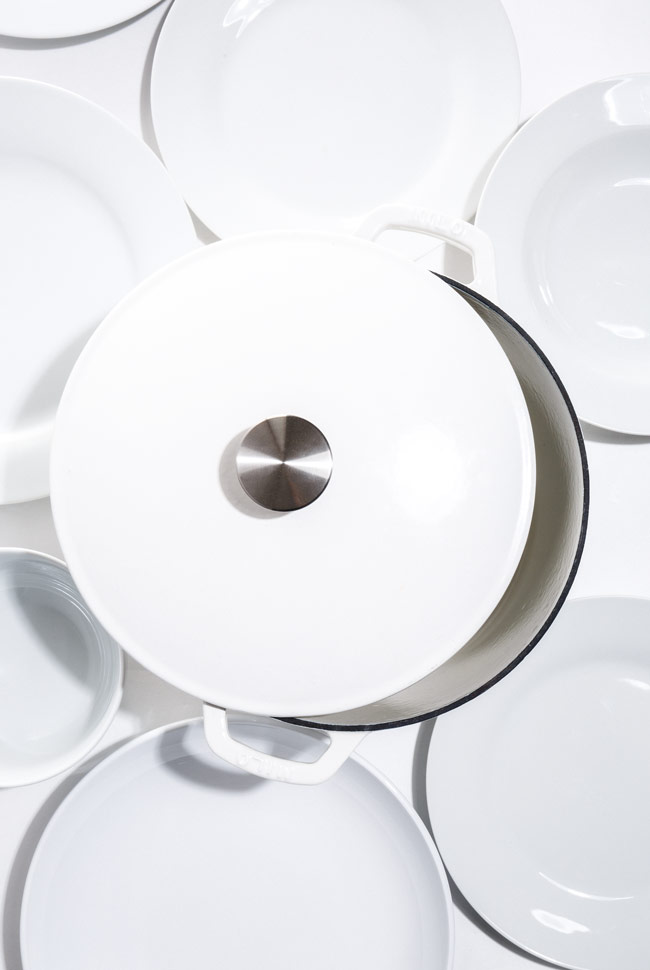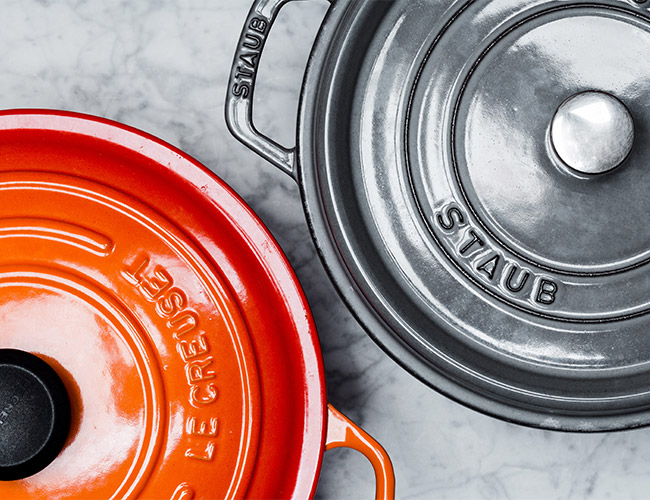The enameled dutch oven is a cast-iron pot coated with a type of easy-cleaning, lower-maintenance glass, granting it the superior heat retention of cast-iron without the need to season ad finitum. The catch? Dutch ovens are not cheap — especially if you want one that will stand the test of time. Leading brands like Staub and Le Creuset are well-made, but require what amounts to a bank account sacrifice to own. More affordable options like Lodge are a fraction of the cost and may function similarly for a short time, but are quicker to show signs of degradation (enamel chipping, crazing, discoloration, etc.).
The Milo dutch oven is new and yet another upstart direct-to-consumer brand that claims to replicate high-end quality for mid-market prices. Its dutch oven is not as cheap as Lodge’s ($95 vs. $45), but it’s still firmly one-third what Le Creuset and Staub demand and claims at least equal performance and long-term durability. A bold proclamation, and one we had to test.
The Good: It held heat noticeably better than my Le Creuset and just about even with a Staub, likely due to the more traditional heavy build it shares with Staub. The Milo also smartly borrows Le Creuset’s lighter-colored interior, which makes for much easier monitoring of browning meats and veggies. The lighter-colored interior cleans with a bit of hot water, a scrub and, at worst, a very small dab of soap.
Outside of the cooking realm, the Milo oven is backed by a lifetime warranty that ensures replacement for any product that shows damage from everyday use. From my personal interactions with its customer service team and its founder, Milo also seems far, far more responsive than your run-of-the-mill direct-to-consumer brand. Finally, though vain and not at all performance-oriented, the creamy white looks damn good perched up on a stovetop or in the center of a dining room table.
Who It’s For: If you want the cooking quality and warranty assurance that comes with Le Creuset and Staub, but don’t care about color options, don’t believe in the power of the self-basting nubs (protrusions on the inside of the lid that some believe collect steam and self-baste whatever you’re cooking) and aren’t in it for the brand name, a Milo may be for you. Its price also frames it perfectly in realistic gift-giving range, and its white color already looks the part for a wedding present.
Watch Out For: My main quibble with the Milo lies in the fit of the lid. It wasn’t a failure or something that ruined any dish I made in it, but it was markedly less tight-fitted than the Staub’s lid and a bit less fitting than Le Creuset’s (an issue I noted when we compared the two a while back). This means you may see a quicker loss of liquid when braising or cooking for long durations. The counterpoint to this is that the lid actually should release some liquid, as you want to evaporate flavor-diluting water.
For now, the Milo comes only in a 5.5-quart size and in creamy white, though founder Zach Schau told me that’s not permanent by any means.

Alternatives: As is usual in the cast-iron arena, Lodge offers a very affordable option that cooks pretty damn well. In testing, Lodge dutch ovens had a much, much poorer enamel coating that stains and scratches more easily (no, I didn’t use metal utensils when cooking with it), requires more elbow grease to clean and have chipped on me only months into cooking. For what it’s worth, despite naming it “best dutch oven,” Wirecutter, acknowledged the Lodge dutch oven did scratch rather easily. They’re also certified safe up to 400 degrees, where the Milo is safe to 450.
Cuisinart offers a 5-quart dutch oven in the same price range as the Milo, but it isn’t clear what sort of warranty backs it and it has received a significant number of reviews pertaining to issues with its enamel coating.
Review: I received the Milo dutch oven a couple months ago prior to its release to begin stress-testing it in the area that matters the most when buying a dutch oven — longevity. Milo, like all other cast-iron peddlers, advertises its product as a heritage good — something you can pass down or gift for others to pass down.
I cooked on it and it exclusively for a month and a half straight — dishes like beef stew, masaman curry, pan-fried chicken, pulled pork hash, lamb shanks and more. The largest single difference in its cooking performance was a slightly faster loss of liquid and reduction process than the other dutch ovens I’ve used and tested. This basically just means you’ll have a more cooked down final product, or simply need to add a bit more liquid initially than you’re used to. I adjusted fairly quickly to the change, and it wasn’t severe enough to make anything objectively bad, just less than ideal for the first few meals.
The handles were a bit on the small side, but, frankly, once you’ve heated the pot you’re not going to be gripping the handles with your fingers wrapped around them. You’ll be using oven mitts, and oven mitts aren’t going to budge through any dutch oven’s handles. You hold the handles from the bottom and lift, so this was not a real issue.
My Milo oven showed no sign of wear in the time I spent cooking with it. Admittedly, I’ve only been testing it for a short time in comparison to how long you’re going to want to keep it. All the same, the lifetime warranty and the short time I’ve spent with it make me comfortable recommending it to anyone who isn’t worried about brand names or color options.
Verdict: The Milo is impressive for the price. It’s solidly $200 more affordable than the ovens it easily keeps up with in performance and warranty. Milo’s customer service — which includes the founder personally answering questions on stories and social media — is speedy and helpful, doubly surprising given this is typically the area cracks begin to show in the direct-to-consumer model. You’ll be hard-pressed to find a dutch oven with a better all-around value.
What Others Are Saying:
• “The pot worked to perfection, maintaining slow, even heat and cleaning easily with only soap and water. My only regret is that Milo weighs as much as Le Creuset and isn’t quite as well balanced when being lifted and poured from. Why would that be? On the other hand, it’s slightly lighter than Martha Stewart.” — Nancy Hanst, Verified Buyer
• “My Stroganoff came together beautifully—the chicken didn’t stick to the base of the dutch oven, the veggies and noodles were deliciously tender. I didn’t hold back in the kitchen: I used both wooden utensils and a steel spatula within the pot, but I didn’t see a scratch afterwards, which is a good sign.” — Zee Krstic, Cooking Light
Key Specs
Weight: 12 pounds (8.5 pounds without lid)
Volume: 5.5 quarts (5.3 liters)
Width: 10.5 inches
Height: 6 inches
Any discussion pertaining to enameled cast-iron begins and ends with two brands. We tested them both to see which was truly superior. Read the Story


